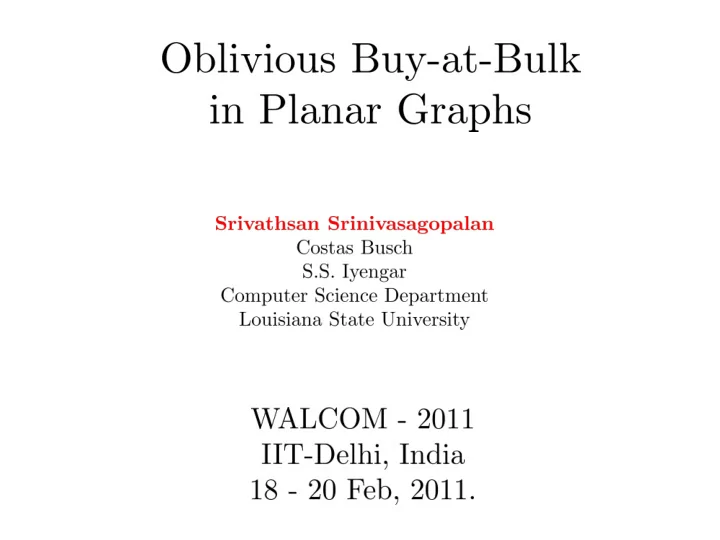

l
t S
Low Color Partitions • Decomposition of a graph into several components (disjoint). • Properties of this partition: – The components have bounded diameter Coloring: – Components that are “close” to each other cannot have the same color. Parameter – Color the partition (at each level) with minimal # of colors.
Why Low-Color Partitions? • Clusters of same color are far away from each other. • Leaders of these clusters are mutually far off. • The real data sources that feed those leaders will also be mutually far away. • The number of such real data sources that are mutually far away are significant (compared to those that are closeby).
Benefit of Low-Color Partitions Cluster Leader
Benefit of Low-Color Partitions Data Sources
Benefit of Low-Color Partitions
Benefit of Low-Color Partitions
Benefit of Low-Color Partitions Higher Level Leader
Path Separators • A set of shortest paths that partition a graph into two or more components of size atmost n/2 (n is total size of the graph). • Path Separators can be computed in polynomial time – Planar Graphs are 3-path separable – H-Minor Free Graphs are k-path separable
Graph Decomposition (Planar Graph)
Graph Decomposition Level 1 Cluster
Graph Decomposition Level 1 Decomposition Length (P i )= c.
Graph Decomposition Level 1 Decomposition Length (P i )= c.
Graph Decomposition Level 1 Decomposition Length (P i )= c.
Graph Decomposition Level 1 Cluster Coloring NOTE: Number of such clusters is small Length (P i )= c.
Graph Decomposition Level 2 Components
Graph Decomposition Level 2 Decomposition
Graph Decomposition Level 2 Clustering
Graph Decomposition Level 2 – Cluster Coloring
Graph Decomposition Over Coloring of Clusters (upto level 2)
Level k Level k - 1 Level k - 2
RSMT Problem • Rectilinear Steiner minimal tree (RSMT) problem: – Given pin positions, find a rectilinear Steiner tree with minimum WL – NP-complete • Optimal algorithms: – Hwang, Richards, Winter [ADM 92] – Warme, Winter, Zachariasen [AST 00] GeoSteiner package • Near-optimal algorithms: – Griffith et al. [TCAD 94] Batched 1-Steiner heuristic (BI1S) – Mandoiu, Vazirani, Ganley [ICCAD-99] • Low-complexity algorithms: – Borah, Owens, Irwin [TCAD 94] Edge-based heuristic, O(n log n) – Zhou [ISPD 03] Spanning graph based, O(n log n) • Algorithms targeting low-degree nets (VLSI applications): – Soukup [Proc. IEEE 81] Single Trunk Steiner Tree (STST) – Chen et al. [SLIP 02] Refined Single Trunk Tree (RST-T) 61
Minimum Spanning Trees • The basic algorithm [Gallagher-Humblet-Spira 83] – O ( m n log n ) O ( n log n ) messages and time • Improved time and/or message complexity [Chin-Ting 85, Gafni 86, Awerbuch 87] • First sub-linear time algorithm [Garay-Kutten-Peleg 93]: 0 . 61 * O ( D n log n ) * n • Improved to O ( D n log ) • Taxonomy and experimental analysis [Faloutsos-Molle 96] D • lower bound [Rabinovich-Peleg 00] ( n / log n )
Steiner Tree Approximations • Gabriel Robins and Alexander Zelikovsky: [J. Discrete Mathematics, 2005] – 1.55 approximation polynomial-time heuristic. – 1.28 approximation for quasi-bipartite graphs. • Hougardy and Prommel : [SODA 1999] – 1.59 approximation • Unless P = NP, the Steiner Tree Problem for general graphs cannot be approximated within a factor of 1 + ε for sufficiently small ε > 0. • Rajagopalan and Vazirani [SODA 1999] : Approximation > 1.5 – Primal-Dual Algorithm • Zelikovsky [Algorithmica1993)]: 11/6 approximation
Applicability Contd … • Distributed Paging: The constrained file migration problem (Bartal) is the problem of migrating files in a network with limited memory capacity at the processors in order to minimize the file access and migration costs. This is a natural generalization of uniprocessor paging problem and a special case of distributed paging problem. In a network G = (V,E,w), a set of files resides in different nodes in the network. Processor v can accommodate in its local memory upto k_v files. The cost of an access to file F initiated by processor v is the distance from v to the processor holding the file F. A file may be migrated from one processor to another at a cost of D times the distance between the two processors. The goal is to minimize the total cost.
Planar Algorithm [Busch, LaFortune, Tirthapura: PODC 2007] • If depth (G) ≤ k, we only need to 2k-satisfy the external nodes to satisfy all of G • Suppose that this is the case
Step 1: Take a shortest path (initially a single node) Step 2: 4k-satisfy it Step 3: Remove the 2k-neighborhood 4k
Continue recursively…
4k-satisfy the path Remove the 2k-neighborhood Discard A, and continue 2k 2k A
And so on … …
Analysis • All nodes are satisfied because all external nodes are 2k-satisfied • Shortest-Path Cluster was always called with 4k, so clearly the radius is O(k) • Nodes are removed upon first or second clustering, so degree ≤ 6
If depth(G) > k • Satisfy one zone S i = G(W i-1 U W i U W i+1 ) at a time • Adjust for intra- band overlaps… W i-1 W i W i+1 … … S i
Final Analysis • We can now cluster an entire planar graph • Radius increased due to the depth of the zones, but is still O(k) • Overlaps between bands increase the degree by a factor of 3, degree ≤ 18
Recommend
More recommend